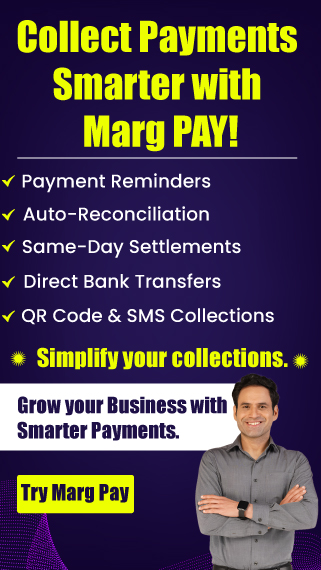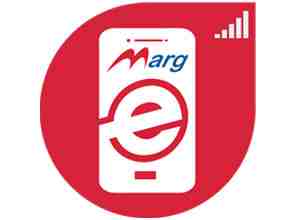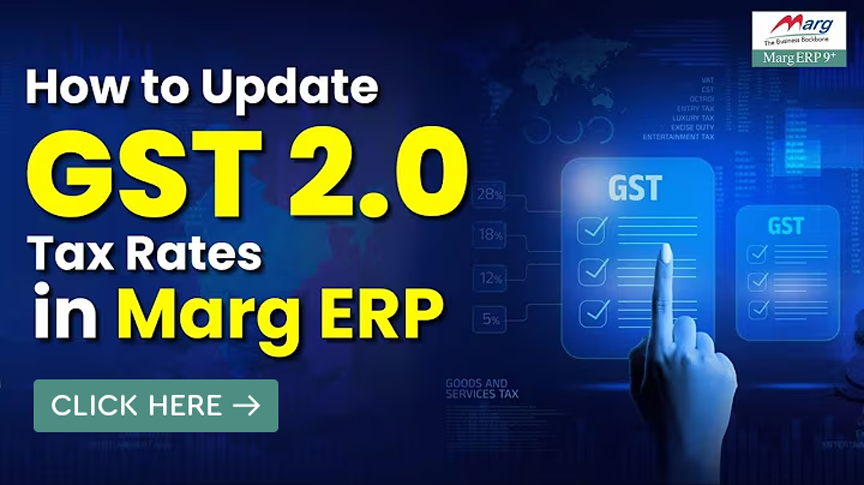Search by Category
- Marg Digital Health
- Marg Nano
- Swiggy & Zomato
- ABHA - Ayushman Bharat
- Marg Cloud
-
Masters
- Ledger Master
- Account Groups
- Inventory Master
- Rate and Discount Master
- Refresh Balances
- Cost Centre Master
- Opening Balances
- Master Statistics
- General Reminder
- Shortage Report
- Supplier Vs Company
- Temporary Limit
- Shop QRID and eBusiness
- Cloud Backup Setup
- Password and Powers
- Marg Licensing
- Marg Setup
- Target
- Budget
- Credit Limit Management
- Change ERP Edition
- Ease Of Gst Adoption
-
Transactions
- ERP To ERP Order
- Sale
- Purchase
- Sale Return
- Purchase Return
- Brk / Exp Receive
- Scrap Receive
- Brk / Exp Issue
- Scrap Issue
- GST Inward
- GST Outward
- Replacement Issue
- Replacement Receive
- Stock Issue
- Stock Receive
- Price Diff. Sale
- Price Diff. Purchase
- BOM
- Conversion
- Quotation
- Sale Order
- Purchase Order
- Dispatch Management
- ERP Bridger
- Transaction Import
- Download From Server
- Approvals
- Pendings
- Accounts
- Online Banking
-
Books
- Cash and Bank Book
- All Ledgers
- Entry Books
- Debtors Ledgers
- Creditors Ledger
- Purchase Register
- Sale Register
- Duties & Taxes
- Analytical Summaries
- Outstandings
- Collection Reports
- Depreciation
- T-Format Printing
- Multi Printing
- Bank Reconcilation
- Cheque Management
- Claims & Incentives
- Target Analysis
- Cost Centres
- Interest and Collection
- Final Reports
-
Stocks
- Current Stock
- Stock Analysis
- Filtered Stock
- Batch Stock
- Dump Stock
- Hold/Ban Stock
- Stock Valuation
- Minimum Level Stock
- Maximum Level Stock
- Expiry Stock
- Near Expiry Stock
- Stock Life Statement
- Batch Purchase Type
- Departments Reports
- Merge Report
- Stock Ageing Analysis
- Fast and Slow Moving Items
- Crate Reports
- Size Stock
-
Daily Reports
- Daily Working
- Fast SMS/E-Mail Reports
- Stock and Sale Analysis
- Order Calling
- Business on Google Map
- Sale Report
- Purchase Report
- Inventory Reports
- ABC Analysis
- All Accounting Reports
- Purchase Planning
- Dispatch Management Reports
- SQL Query Executor
- Transaction Analysis
- Claim Statement
- Upbhogkta Report
- Mandi Report
- Audit Trail
- Re-Order Management
- Reports
-
Reports Utilities
- Delete Special Deals
- Multi Deletion
- Multi Editing
- Merge Inventory Master
- Merge Accounts Master
- Edit Stock Balance
- Edit Outstanding
- Re-Posting
- Copy
- Batch Updation
- Structure/Junk Verificarion
- Data Import/Export
- Create History
- Voucher Numbering
- Group of Accounts
- Carry Balances
- Misc. Utilities
- Advance Utilities
- Shortcut Keys
- Exit
- Generals
- Backup
- Self Format
- GST Return
- Jewellery
- eBusiness
- Control Room
- Advance Features
- Registration
- Add On Features
- Queries
- Printing
- Networking
- Operators
- Garment
- Hot Keys
-
GST
- E-Invoicing
- Internal Audit
- Search GSTIN/PARTY
- Export Invoice Print
- Tax Clubbing
- Misc. GST Reports
- GST Self-Designed Reports
- GST Return Video
- GSTR Settings
- Auditors Details
- Update GST Patch
- Misc. GST Returns
- GST Register & Return
- GST RCM Statement
- GST Advance Statement
- GST Payment Statement
- Tax Registers and Summaries
- TDS/TCS Reports
- Form Iss./Receivable
- Mandi
- My QR Code
- E-Way Bill
- Marg pay
- Saloon Setup
- Restaurant
- Pharmanxt free Drugs
- Manufacturing
- Password and Power
- Digital Entry
Home > Margerp > Gst Queries > GSTR 1: FAQ's
GSTR 1: FAQ's
Frequently Asked Questions
GSTR 1 is a Monthly/Quarterly Statement of Outward Supplies to be furnished by all normal and casual registered taxpayers making outward supplies of goods and services or both and contains details of outward supplies of goods and services.
Every registered taxable person, other than an Input Service distributor/Compounding taxpayer/TDS Deductor/TCS Collector is required to file GSTR 1, the details of outward supplies of goods and/or services during a tax period, electronically on the GST Portal.
GSTR 1 needs to be filed even if there is no business activity (Nil Return) in the tax period.
GSTR 1 can be prepared using the following modes through:
a. Online entry on the GST Portal
b. Uploading of invoice and other GSTR 1 data using Returns Offline Tool
c. Use JSON from Marg Software
The following taxpayers are not required to file GSTR 1:
a. Taxpayers under the Composition Scheme (Return to be filled by them in GSTR 4)
b. Non-resident foreign tax payers (Return to be filled by them in GSTR 5)
c. Online information database and access retrieval service provider (Return to be filled by them in GSTR 5A)
d. Input Service Distributors (ISD) (Return to be filled by them in GSTR-6)
e. Tax Deducted at Source (TDS) deductors (Return to be filled by them in GSTR 7)
f. E-commerce operators deducting TCS (Return to be filled by them in GSTR 8)
The due date to file GSTR 1 for a given tax period is 10th day of the succeeding month.
For example, GSTR 1 for Goods/Services supplied during the calendar month of November 2017 should be filed by (23:59:59 hours) on 10th December, 2017.
The turnover value in Table 3 of GSTR 1 has to be entered manually for the first year as the information is not available with the GST system. From the second year of implementation of GST, the system will auto-calculate the turnover based on all the annual returns filed for all the GSTINs associated with a given PAN (PAN-based turnover). However, the turnover value will be editable and you will have the option to amend it.
The ‘Total Invoice Value’ column in GSTR 1 is for the Invoice Value Inclusive of Taxes.
Yes, you can enter details of Goods and Services in the same invoices.
B2B Supply refers to supply transactions between Registered Taxable Entities/persons (Business-to-Business supplies).
B2C Supply refers to supply transactions between a Registered Supplier and an Unregistered Buyer (Business-to-Consumer).
A Debit Note is a document issued against an invoice in cases where the original invoice was issued at a value lower than the actual value of goods and/or services provided. It can also be issued in case of post supply price negotiations. The difference amount is accounted for in the form of a Debit note
Credit Note is a document issued against an invoice in cases where invoice was issued at a value higher than the actual value of goods and/or services provided or the invoice value is reduced due to post supply negotiations. This may also happen when the goods supplied are returned by the recipient, or where goods or services or both supplied are found to be deficient.
Debit Notes are to be reported in the return of the month in which they are issued by the supplier.
Credit Notes are to be reported in the return of the month in which they are issued but not later than the return of the September month following the end of the financial year in which such supply was made, or the date of furnishing of the relevant annual return, whichever is earlier.
No. In case of supplies to consumers are to be reported in a consolidated manner (intra-state supplies to consumer and inter-state supplies of invoice value less than INR 2.5 lakhs), the credit/debit notes are not required to be reported separately. Such supplies have to be reported in a consolidated manner net off the values of credit and debit notes.
Yes, Supplier is liable to pay tax on advances received from Receivers for the supply of goods and services and report the consolidated advance received details in month in which payment is received. The amount of advances to be reported in GSTR 1 is net off the amount for which invoices have already been issued and the value reported in the same return in other sections.
The taxpayer has to declare the advance that has to be adjusted in the tax period in which advance is received. Subsequently when invoice is issued,then taxpayer can adjust the tax liability of the invoice issued of that tax period, in the GSTR 1 of that period. This can be shown in the advance adjustment table of GSTR 1.
Exports are generally treated as Zero-rated Inter-State Supplies. In case of exports, the taxpayer has the option to export without payment of any integrated tax and claim refund of ITC (against the exports made) or the taxpayer may pay IGST and claim refund of the IGST amount paid (post affecting the exports).
As the SEZ unit or SEZ developer are registered and have GSTIN, the invoice details of supplies to them need to be reported in the section of supplies to registered taxpayers (B2B invoice details) with appropriate SEZ flag.
Yes. The return provides for the declaration of the details of all taxable Supplies effected through E-Commerce along with the GSTIN of the e-commerce portal in
GSTR 1. However, this would be implemented once the relevant provisions of GST law are notified.
It should be reported in a consolidated manner in the nil rated and exempt supply section of the GSTR 1.
The recipient of goods and services is liable to pay tax under reverse charge mechanism, if the said goods or services are notified to be subject to Reverse Charge and if they are received from Registered/Unregistered persons by the recipients and its value is more than specified threshold.
There might be the following reasons that excel file is not generated in GSTR -1
1.Excel is already open in background or any excel file is already in Used then close the excel file through task manager after that try again to generate excel file.
2.You can check your antivirus and disable it or uninstall the antivirus of third party from control panel.
A composition dealer will have to file GST 4 return.
Normally, the supplier of goods or services pays the tax on supply. In the case of Reverse Charge, the receiver becomes liable to pay the tax, i.e., the the liability to pay tax is transferred to the recipient of supply or any other designated person.
Unlike the current law, reverse charge is applicable to goods also In case of receipt of any supply (of goods or services) from an unregistered supplier, the registered person who is receiving those supplies is liable to pay tax under reverse charge Import of services will fall under reverse charge
Certain other supplies will also be notified by the Government and will fall under reverse charge where the recipient will need to pay GST.
There is no minimum threshold (of INR 20 lakhs) for reverse charge, and the registered recipient will
need to pay tax for any supply under reverse charge.
Tax paid under reverse charge can be taken as ITC (subject to restrictions) [Section 24 of the CGST Act]
Tax paid on reverse charge basis will be available for input tax credit if such goods and/or services are used, or will be used, for business. The recipient (i.e., who pays reverse tax) can avail input tax credit.
The rate of GST applicable on gold bullion and gold jewellery is the same – 3%.
However, when the bullion is purchased, GST will be applied once @3% and when the bullion is
converted to jewellery, there will be another GST on the outward supply of such jewellery @3%.
If the artisan is engaged on a principal to principal or business to business level, it is taxable
If they are directly employed by the principal, the services will not be taxable under GST, as services
by employee to employer are not liable to GST.
Under GST, supplies of goods by principal to agent are taxable; and
The agent can avail the ITC and offset it against output GST once he sells the goods to third parties.
No, job work is a ‘supply of service’ under GST, and composition scheme is not available for services.
Recipient needs to pay the tax directly to the Government under reverse charge
Recipient also needs to issue an invoice for the supply [Section 31(3)(f) read with rule 1 of the Invoice Rules]
Recipient also needs to issue a payment voucher when making payment to the karigar
The TDS provision under GST is applicable only to Government and Government undertakings receiving goods or services under a contract value of more than Rs. 2.5 lakhs. Government will also notify some other persons who will fall under the TDS requirement. Unless notified, TDS will not apply to the gems and jewellery sector.
Registration conditions are the same as for other sectors
Suppliers having turnover of more than 20 lakhs (10 lakhs in special category of states) need to take
registration under GST [Section 22 of the CGST/SGST Act]
Those who are registered under the existing law can migrate their current registrations to GST
Apart from this, there is compulsory registration of certain categories of persons to whom the minimum threshold limit does not apply. This category includes:
Persons liable to pay tax under reverse charge
Persons making inter-state supplies
Persons making taxable supply on behalf of other taxable persons, whether as agent or not
Input Service Distributor
Persons who supply goods and services through e-commerce operators
If Supplier Provide Letter of Undertaking with in 90 Days then Tax will be Zero
In this case user needs to remove the special character from the HSN Description of Item.
In this case user needs to put GSTIN No With Date in Party Master. After that Bills created before that Date will post as for Unregistered Party and bills created after the GSTIN No date will post as for Registered Party.
There are 2 case for Export Bills:
Case 1: If Export Bill in GST is with Bond then Gst will not effect.
Case 2: If Export Bill in GST is without bond then it will effect on GST.


 -
Marg ERP 9+
-
Marg ERP 9+











